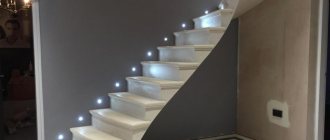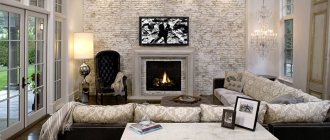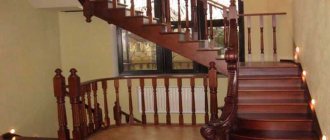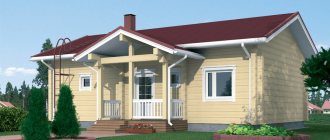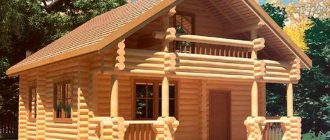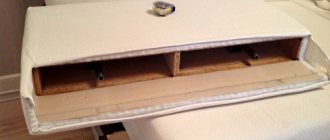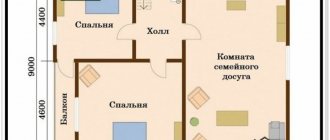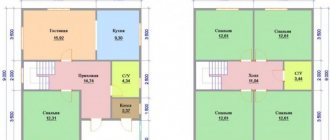One stain will not be enough to treat a pine surface. As a coating, it does not provide a barrier to moisture penetration. The tree becomes loose over time. For pine, stain is a material for tinting. It penetrates into the wood, emphasizing the texture. Even if the varnish coating is worn out, the stain will help preserve the color of the entire wooden structure for a long time.
Wood is popular as a building material. Furniture and many interior items are made from it. But since it needs protection from rodents, insects, and weather conditions, it must be properly processed.
Among other species, pine is distinguished by its reasonable price and beautiful texture. For these two reasons, it is it that is most often used for the manufacture of stairs. In order for a wooden structure to become even more beautiful and serve for many years, you need to figure out how to properly treat it, which varnish is best for a pine staircase.
Ladder varnish is necessary for the final painting of the object. It protects wood from climatic factors, preserves its attractive appearance, and extends its service life. Before purchasing a solution, you need to familiarize yourself with the types of mixtures. Understanding the application technology will prevent mistakes.
Varnish for stairs: types and differences
What it is
A paint and varnish product is a solution that forms a protective layer on the surface being treated. The film prevents the effects of harmful substances and factors and preserves the mechanical properties of the object. Modern stores provide a wide range of mixtures. Selecting a solution can be difficult. Knowing the types of quick-drying compounds, their advantages and disadvantages will save you from waste. Design characteristics and wood type play a significant role. It is important to consider them when purchasing paint and varnish composition.
Types of varnishes
There are several types of varnish for stairs:
Often the result of painting depends on the choice of paint and varnish! This is interesting: how to choose a yacht varnish.
Oil-based varnish Alcohol varnish Alkyd varnish Nitrocellulose varnish Epoxy varnish Polyurethane varnish
Liquid varnishes must be applied with natural brushes. The length of the bristles should be 2 times greater than the diameter of the brush. If a thick composition is applied, the brush should have short bristles. Before varnishing, it is important to perform the following steps:
Price range
It is more logical to assume that the more stable the wood and the more positive qualities it has, the more expensive it is and will last much longer. If you don’t have enough money, you can combine the staircase with different types of wood. So what kind of wood is best to make a staircase from? For example, steps, which, due to the load placed on them, naturally must be stronger and made from hard and wear-resistant wood, but the support columns will be created from more inexpensive materials.
Selection of varnish depending on the type of wood
When choosing a paint and varnish material, it is important to consider the type of wood from which the stair elements are made. If you need to varnish coniferous wood containing a large amount of resin, then it is better to choose some kind of opaque varnish mixture.
When varnishing hornbeam, beech, ash or oak, as well as other exotic wood species, it is best to choose a colorless composition that will emphasize and highlight the natural attractiveness and texture of the wood. If there are any defects on the wood, the surface is first puttied to mask the damage, after which the base is sanded, and then a varnish solution is applied.
The production of alkyd varnishes is based on alkyd resins dissolved in white spirit or other organic solvent. They have high wear resistance, increased strength, and are not afraid of changes in temperature and humidity. So they can be safely used when processing street stairs.
Susceptibility to putrefactive processes
So what kind of wood should a house's staircase be made of so that after some period of time it is not spoiled by this unpleasant influence? This point of general characteristics should be given the closest attention. Especially for the outside of the house or rooms with high humidity levels. The most hardy and practically not susceptible to putrefactive processes are larch and oak.
Useful tips
Experts who do painting frequently and treat large areas give some advice in this matter.
Between glossy and matte paints and varnishes, it is better to give preference to the latter. The surfaces of the steps treated with them do not slip, which is the main criterion for safe operation for staircase structures.
If brushes or a paint roller are used to paint a wooden staircase, then the first layer of material is applied along the grain of the wood, the second across it, and the third again along it. It must be taken into account that subsequent layers of composition are applied to the previous ones only after they have completely dried.
Note! If long-drying compounds are used, then it is better to paint the steps one at a time in order to leave the possibility of moving along the staircase structure.
Before moving on to painting, it is recommended that, in addition to the stairs and its parts, you clean the entire room. Because dust from the same floor or window sill can rise and settle on the varnished surface, reducing its quality and presentable appearance. The wall near the stairs should be sealed with masking tape, which will help to carry out the work carefully and get clear, even lines.
Such structures have a number of advantages that open up wide opportunities for owners of private houses.
Types of steps
Oak furniture and various wood accessories have never been considered cheap. This is explained by the complex preparatory process (drying and staining) of the workpieces. The result is a high quality product. Not everyone can afford to purchase oak products, however, the price does not count when the splendor and durability of the product are at stake. Therefore, when cladding flights of stairs, oak tiles are often used, guided precisely by their long service life. Oak steps last a long time without changing their positive characteristics.
There are 3 types of steps
Kinds:
- Solid. To create them, a whole piece of wood is used, and the structure of the wood pattern does not change. The main condition before installing the panels is that the wood must be kept for some time in the room where the adaptation work is supposed to be carried out.
- Solid lamella. Products are obtained by superimposing horizontal plates on top of each other. The pattern in this case is not lost.
- Spliced. The method is good if you need to create a very durable wooden structure. The method is based on merging several lamellas with tenons or grooves in the vertical direction. It is in demand when lining the treads of a flight of stairs.
What types of staircases are there?
Like all equipment and safety items in the home, stairs have their own designs and structures. They are selected depending on the space allocated for the equipment. The assembly diagram can be:
Marching
The marching structure is often chosen for arrangement. The drawing for this option is as simple as possible. And it can also be done with your own hands by a person who has not previously encountered such tasks.
These can be staircases with a turn and straight stairs leading directly to the second tier of housing.
You should choose what kind of design it will be based on how much area in the room is allocated for the stairs.
Screw
A spiral wooden staircase will help save significant space in the building. It looks very harmonious and attractive. There is one drawback that stops people who want to draw a drawing and install screw steps with their own hands.
It is quite difficult to take correct measurements and implement the installation of a spiral staircase. This requires at least minimal skills in this area.
Hanging
This staircase will help in homes where space is limited. In this case, the steps are attached to the wall, and railings are installed on the side. To carry out such work, it is enough to calculate the number of steps required and have a drill and screwdriver. With simple steps, the steps are fixed at the required points. The only thing before betting on such a structure is to pay attention to the strength of the walls. After all, they will bear the main load when people walk to the second tier and down.
Anyone who has a great desire to make a drawing of a staircase for their home with their own hands will definitely be able to do this. The most important thing is to adhere to the rules, sequence and clarity of actions.
Therefore, you need to start choosing with material requirements:
Lacquer coating of stairs
Classic lacquered staircase
Often the lining and stairs to the second floor in a house are made of pine. This is a good material, has excellent characteristics and a special aroma that allows you to create a unique atmosphere of naturalness and comfort. In addition, the material contains special resins that protect the wood to a certain extent.
But how can we protect the material and make it more durable? To do this, you need to use a special coating, even if the staircase will be used inside the house. The most traditional way is painting. This composition provides reliable protection, but is not without one drawback - we lose sight of the structure of the material and do not fully feel its naturalness. However, high-quality paint can give the product a special appeal.
Another option for covering a wooden staircase in your home is to use a clear varnish. It will just allow you to admire the wood in all its glory.
How to paint
- brush;
- roller;
- spray.
Protection with paints and varnishes
So, let’s summarize what paint and varnish materials will protect wood products from:
- mechanical impacts - constant movements along the steps will not cause such negative consequences, deep scratches in the material, the main load will be taken by the protective layer;
- You can cover the steps of a wooden staircase from high humidity or temperature changes.
Before choosing paints and varnishes, you should take into account the operating conditions of the stairs in order to avoid problems.
Requirements
Therefore, you need to start choosing with material requirements:
Materials
Let's return directly to the choice of paints and varnishes, having examined in more detail two options: paint and varnish.
However, one more point should be taken into account. When choosing a composition, you need to consider the type of wood. For example, coniferous materials, say pine, absorb the mixture heterogeneously, so you will need to create several layers. Don’t forget that pine needles release resins that prevent the surface from adhering to the coating. With hardwood, everything is somewhat simpler, since they absorb mixtures better and require less paint and varnish materials.
Dye
You need to choose a shade that will be most in harmony with the current natural color of the steps or other wooden elements of the staircase. This will allow you to cover the material with better quality, preserving the natural appearance of wood.
The type of paint is determined by the operating conditions of the structure: indoors or outdoors. These conditions are usually indicated on the packaging of the consumables; all you have to do is correlate them with your realities and select the required volume, taking into account the area, as well as the fact that more than one layer will need to be applied.
Varnishing a wooden staircase is an excellent solution, but it requires similar decisions as with paint. That is, you should determine what varnish to coat a wooden staircase with.
You should choose a colorless varnish, then the structure of the wood will be visible. At the same time, varnish has an important advantage over paint: it dries faster. Although, of course, it all depends on the chosen composition and manufacturer.
Modern production offers two mixtures:
- alcohol-based varnishes;
- nitrocellulose varnishes.
The first option is resin mixed with an organic solvent. The composition is used inside the house. Low temperatures and other weather conditions have a very negative effect on the properties of such varnish.
For outdoor use, a nitrocellulose composition is more suitable.
Adviсe
Finally, here are some useful tips for those who have already decided on the composition:
- It is better not to cover all the steps at once, but one at a time, so that the stairs can be used while the material dries;
- you need to consciously choose the start time of work to ensure minimal discomfort for others, for example, painting can be done late in the evening so that the stairs can be used by morning;
- The mixture can only be diluted with the composition that it contains, for example, if the paint is water-based, then it can be diluted with water.
As you can see, there is nothing difficult in choosing paint and varnish materials to cover the stairs leading to the second floor of the house. It is important to take into account the operating conditions, the decorative effect and apply the composition efficiently, then the steps, like the entire structure, will last as long as possible. And the result can be seen in the photo and video.
Added: 12/20/2016 21:32:44
This product is based on wax and the following types of natural ingredients:
- Sunflower;
- Linen;
- Jojoba oil;
- Beeswax;
- Candelline wax;
- Carnauba wax.
Today, oil successfully competes with varnishes: it penetrates deeply into the wood, highlights the external advantages of the material and copes well with its protective functions. Due to the bactericidal properties of the oil, fungi do not appear on the stairs.
Advantages of impregnation:
- Water-repellent characteristics;
- Easy to apply;
- Extends the service life of steps;
- Does not have an unpleasant odor.
To darken the color of wood, it is better to use stain rather than colored varnish. The stain is absorbed into the wood to a depth of several millimeters. This means that even if the wood wears out and wears out, it will not change its color. To slow down this process and add strength to the coating, it is necessary to apply an additional layer of transparent paint and varnish material, which is the final stage.
Geometric parameters of steps
As you know, all objects are measured by basic parameters: length, width and height. Wood steps are no exception:
- height – accepted in the range from 15 to 22 centimeters;
- depth - the horizontal part on which a person rests his foot;
- width - the distance between the two edges of the flight of stairs;
- The thickness of the riser and tread is at least 25 and 35 mm, respectively.
Attention! The size of the tread depth can vary in turning and spiral staircase models. This way, each family member can choose which side is better to go up or down.
Based on the data obtained, the angle of inclination of the staircase with the number of treads is determined.
Optimal slope of the stairs
The inclination of the staircase design affects how much space it will take up in the room. If the room is huge, you can freely install a large staircase with a wide flight of stairs. In small rooms the rise is steeper.
For ease of movement, the slope is taken to be from 23 to 37 degrees. When the number is less than 23, the span is easily replaced with a ramp - a flat surface connecting two others at different heights.
The slope should not be less than 23 degrees
Calculation of the number of steps in a march
To determine the number of steps required for a climb, you need to measure the height of the floor (rise) and divide by the height of the proposed wooden step for the stairs. If there is a turntable, two calculations are performed with two lifting heights: from the floor to the platform and after it - to the next floor. The thickness of the floor on the next floor must be taken into account.
Wooden steps can be determined graphically. This method involves the use of graph paper, onto which a flight of stairs is transferred to scale. Using special safety formulas and the height of the room, the depth of the tread is determined. The remaining wooden steps are taken according to the obtained dimensions.
This is interesting: how to make calculations for stairs using a constructor?
Application instructions
Before starting work, you need to wear safety glasses, gloves and a respirator. Finishing should be done in a well-ventilated area. Paint and varnish coatings have varying degrees of toxicity and regardless of what material the stairs are processed with, it is better to play it safe and protect yourself and your health. To cover the stairs with paint and varnish material you will need:
- turpentine,
- varnish,
- tassels,
- wire brush or sanding tool.
You should choose a brush with strong bristles.
Finishing with liquid compositions should be done using natural bristle brushes, and with thick ones - with round hair brushes. There are some recommendations from experts: First of all, the surface of the wooden staircase is cleaned of the previous coating, dirt, dust, and grease. Nothing can be left out to guarantee a perfect appearance.
Sanding the stairs before varnishing.
If you have to work with liquid compositions, then the pile should be 2 times longer than the diameter of the brush. If the choice fell on thick compositions, then the pile, on the contrary, should be shorter. The brush must be dipped in varnish and then cleaned with turpentine. Further actions should be carried out according to very simple instructions.
Dip the brush into the varnish solution.
If there are any defects, finishing should be done only after priming. The varnish must be thoroughly mixed so that there are no formations. To achieve the best result, you need to hold the brush at a right angle. Otherwise, the layer will be applied unevenly, which may affect the final result. The varnish is applied in wide strips over the entire surface, after which it is necessary to go over again, smoothing out the unevenness.
The varnish is applied slowly and carefully.
High-quality brushes are distinguished by reliable fastening of the bristles, but nothing can be guaranteed 100%. To avoid any unpleasant surprises after drying, it is better to check the wooden stairs for lint. It is also worth stirring the paint and varnish material not only before starting work, but also periodically. Coating the stairs with varnish. https://www.youtube.com/watch?v=fvQEfkcMGK8 Varnishing balusters and staircase posts. https://www.youtube.com/watch?v=zi3Ydm11urU
We will need (in the example under consideration, puttying is not required, so we did without a primer):
Varnishing a staircase is a simple task, but you need to know some little things in order to ultimately enjoy the result of the work done, and not look for ways to reverse the consequences! Before varnishing, you need to sand the surface, then clean it, you can prime it, putty if necessary, and only then cover it with varnish (avoiding its thickening)…
Finishing a wooden staircase (including varnishing the staircase) carries two key functional components. This is, firstly, decorative and, secondly, protective. With the first, everything is clear: there is some kind of design idea, there is some kind of color scheme, there is simply a desire to change the appearance of the structure. The second is designed to preserve not only the appearance of the staircase, but also its integrity. And in this matter, paint and varnish coatings have proven themselves to be excellent.
So, varnishing the stairs! General steps: it is necessary to sand the surface (if desired or if necessary, cover with a primer, putty, prime again), thoroughly clean the stairs from wood dust, and varnish. We'll talk about some of the pitfalls of this process further.
We will need (in the example under consideration, puttying is not required, so we did without a primer):
- Sandpaper
- Varnish
- Container for varnish
- Brush
- Solvent
- Vacuum cleaner
- Wet and dry rags
Upon completion of surface preparation, all wood dust should be removed. You can use a regular vacuum cleaner for this. After this, the stairs should be wiped with a slightly damp cloth (otherwise you can varnish fragments of dust, which will eventually come off along with the varnish). And, of course, let the wood dry.
Then the actual process of finishing the wooden staircase with paint and varnish begins. By and large, there are no particular difficulties in this procedure. But despite this, a number of recommendations should be highlighted
How to varnish a staircase
That's all. The staircase varnishing is complete!
4, total, today
Wood of medium and low density is initially treated with abrasives No. 40 - 60 , and for finishing it using abrasives No. 180 - 200 .
How to paint a pine staircase with paint or enamel
How to paint the steps of a pine staircase with varnish or paint? The sequence of work is as follows.
Important: All work with paints and solvents should be carried out in the warm season to ensure constant ventilation of the room.
- Cover the floor around the stairs with film. Cover the walls adjacent to the stairs with masking tape.
- Using a scraper and rags, clean the surface from dirt. If there are resin pockets in the wood, carefully cut them out with a sharp knife. Treat old paint with a cleaning agent and smooth it out with sandpaper or a sander.
Level the surface of the steps with sandpaper or a grinder
- Use a vacuum cleaner to remove any accumulated dust and wipe the surfaces with a slightly damp cloth.
- Treat knots, nail heads and screws with sealant to prevent further release of resin.
- Fill cracks, dents, and resin pockets with putty using a spatula. After the putty has dried and shrinked, repeat the procedure 1-2 more times to get a smooth surface. Sand with sandpaper and wipe off dust.
- Using a wide brush or roller, apply the primer evenly to the wood.
- After the primer has dried, apply impregnation.
- After the impregnation has dried, apply the first coat of paint. First, paint the corners with a narrow brush, then use a mini roller or a wide brush to paint larger areas. If the roller leaves a textured surface, smooth it out with a wide brush.
If the new paint strongly contrasts with the previous one or with the color of the wood, for the first layer prepare it more liquid, diluting it with a solvent by 10–20%. Then the paint will lie smoothly, without longitudinal stripes or marks.
- After the first layer has dried, apply the finishing coat of paint in the same order.
- At the same time, paint the railings, balusters, and vertical side surfaces with a brush. You can apply paint with a brush along and across the direction of the fibers, but the final strokes should only be longitudinal. So that during work you can use the stairs to the upper floor, paint the steps one at a time. Mark unpainted areas that you will walk on with colored masking tape. After the first part of the steps has dried, transfer the marks to them and start painting the second half.
- The varnished pine staircase must be completely dry. This period is indicated by the manufacturer on the packaging of the varnish or oil. But, as practice shows, the drying speed is affected by the conditions in the room. Therefore, it is better to wait a couple more days so that the painted surface is guaranteed to dry.
Video: How to properly paint steps
Impregnation - working on the wood texture
To coat wooden parts of stairs, special compounds are also used, which are generally called impregnations.
They are pigments diluted in water or solvent. When tinted with impregnations, the wood texture does not darken, but appears more brightly, due to which it retains its natural shine.
The most famous impregnation is stain. It is usually sold in powder form, which dissolves in water or alcohol.
The resulting composition is then impregnated with wood. After treatment with stain, it is advisable to coat the product with colorless varnish. Substances made from fine dispersions penetrate deeply into the wood, so the coating treated with impregnations is preserved for many years.
Oak
Number one in the manufacture of stairs for country mansions or houses. Thanks to its high quality indicators, aesthetic characteristics, and strength, it has won the championship in the ranking of the best materials for the construction of stairs. Its color range ranges from delicate milky yellow to rich wine-brown. After some time, slight heterogeneous darkening is observed. This is a very dense and hard type of wood that has a high degree of resistance to external influences. Oak is strong, durable and that is why it has a high cost. So which wood to choose for country house stairs? This material is perfect for creating steps. Since ancient times, furniture, decoration, and staircases made of oak were considered an enviable luxury, which only high-ranking officials and people with a high level of income could possess.
Laminate or PVC
We will not consider ordinary linoleum, because rolls are not so convenient to adjust to the desired size, unlike ready-made laminate dies and PVC tiles. They are ideal for mounting on steps.
First, a few words about laminated boards:
- In order to maintain the attractive appearance of the staircase steps, the corners must be covered with special corners;
- If you do not install a sound-absorbing substrate, then moving up the stairs will be very loud, especially at night in complete silence;
- Laminate is quite slippery, and when going downhill in socks or immediately after wet cleaning there is a high risk of slipping and falling, so it is best to use additional pads.
With PVC tiles things are much simpler. It is easy to install without problems, easy to cut and is famous for its large selection of designs.
In its structure, it is somewhat similar to household linoleum, but much stronger and more durable. For vinyl tiles, you will also need end fasteners and corners on the long side. Instead of planks, you can attach simple skirting boards, the main thing is that they match the style.
How to paint
To process pine stairs, the following are used:
- Impregnations with antiseptic and fire retardant properties. They are made on a water, alcohol, acrylic, wax base.
- Stains (stains) for tinting wood. Pigmented impregnations do not form a surface layer, but penetrate into the fibers and make the wood texture expressive. They are made on a water, alcohol, acrylic, oil, wax, and chemical basis.
- Polishes. A transparent coating is applied to the wood, preserving its natural color and pattern, providing a radiant glossy and semi-gloss shine. Can be applied to a layer of paint or varnish to enhance the decorative effect of the coating. It is made on a water, alkyd, oil, wax base.
- Lucky. Transparent material that does not hide the natural appearance of wood. Creates a durable protective layer. It is made on an oil, alcohol, nitrocellulose base. Apply over stain.
- Enamels. They are pigmented varnishes. They form a protective colorless or decorative, glossy or matte hard layer. They have a slight odor and dry quickly.
- Paints. Create a decorative protective layer. Selected by color to match the overall interior design. They are made on an alkyd, oil, acrylic base. They mask minor wood defects and are applied to protective impregnation and previously painted surfaces.
To ensure a high-quality and durable coating, cover the wood only with high-quality materials purchased in specialized stores or from manufacturers.
Which painting material to choose: comparison table
| Types of paints | Advantages | Flaws |
| Oily | Moisture-resistant, rich in color, creates a reliable protective film | They take a long time to dry, do not “breathe”, have a strong toxic odor, lose their shine in areas of wear, are afraid of alkalis, and can peel off over time |
| Enamels | Moisture resistant, form the most durable and smooth surface, dry quickly, lie flat | They provide only a matte surface and are intended for interior use only. |
| Acrylic, acrylate | Water-repellent, breathable, water-soluble, quick-drying, low odor, lays flat | They only provide a matte surface. |
| Alkyd | Moisture-resistant, dry quickly, form a smooth surface with a polishing effect | Contain solvents, have a pungent odor that lingers in the room for some time, a short-lived coating, and may peel off over time |
Preparatory work
- First, all existing construction debris is completely removed.
- If necessary, wash the levels and elements of staircases.
- Dry it.
- Assess the need for puttying and grinding work. They are performed if necessary.
Prepare the surface for finishing work.
Attention! If puttying is done, you will have to wait at least 48 hours for the solution to completely set. Then the excess is removed with abrasive materials and the surface is ground. It happens that such operations are performed several times.
Ash
This type of wood is ideal for creating stairs. It has an incredibly beautiful color, which ranges from light shades of yellow to rich dark brown. The neat texture has a beautiful pattern of growth rings. Ash is very durable, ductile, flexible, has impact strength, and is easy to process and sand. Its only drawback is its susceptibility to rotting, however, as long as normal humidity levels are maintained, you don’t have to worry about this. Unfortunately, it is susceptible to cracking. So what types of wood are staircases for houses made from? This type of wood is almost similar to oak in many respects. It is still not clear why it has not become as popular as oak. Due to its advantages, ash can be used to create the most magnificent staircases, which are in no way inferior to oak structures.
